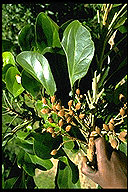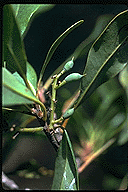 Dilobeia thouarsii Roem. & Schult.
Dilobeia thouarsii Roem. & Schult.
 Dilobeia thouarsii Roem. & Schult.
Dilobeia thouarsii Roem. & Schult.
The studies of Johnson & Briggs (1981) have revealed two independent relict lines of Proteaceae in Madagascar. Isolated dioecious Dilobeia (2 spp.), the sole member of subtribe Dilobeiinae appears to be sister to the subtribe Cenarrheninae consisting of two monotypic genera on Tasmania (Agastachys and Cenarrhenes), two genera endemic to New Caledonia (Beaupreopsis (1 sp.) and Beauprea (12 spp.; with fossil distribution in Australia and New Zealand)), and a more xeric taxon Symphionema (2 spp.) in N.S. Wales. From a base number of N = 14 for subfamily Proteoideae, chromosomal evolution indicates aneuploid reductions from Cenarrhenes (N = 14) to Agastachys (N = 13), Beauprea and Beaupreopsis (N = 11), and Symphionema (N = 10), as well as polyploidy in Dilobeia (N = 24).
 Malagasia alticola (Capuron) L.A.S. Johnson & B.G. Briggs
Malagasia alticola (Capuron) L.A.S. Johnson & B.G. Briggs
Ambohitantely Special Reserve, type locality of Malagasia alticola
Subtribe Hicksbeachiinae of subfamily Grevilleoideae is comprised of Malagasia (1 sp.) in Madagascar, Athertonia (1 sp.) and Hicksbeachia (2 spp.) in N.E. Australia, Virotia with 6 spp. probably endemic to New Caledonia (plus 1 sp. doubtfully placed in the genus from Queensland), and Heliciopsis with 7 spp. restricted to W. Malesia. Relationships among the genera are not fully resolved, but if Malagasia is most closely related to Heliciopsis as suggested by Johnson & Briggs (1981), then one could propose rafting of the ancestors of Heliciopsis on India, dispersal into W. Malesia, and subsequent extinction in India.